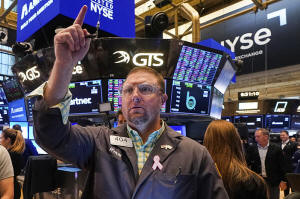How Wall Street powered to a record high and what comes next
[June 28, 2025] A
trade war. A real war with bombs dropped in the Middle East. A barrage
of insults hurled by the president of the United States at the head of
the Federal Reserve.
The stock market has powered through all of that in the past few months
to set a new record Friday and reward investors who stayed their ground
through a volatile stretch. The S&P 500 closed at an all-time high of
6,173.
While Wall Street can take a bow — and breath a sigh of relief — there's
no let-up ahead. The pause President Donald Trump put in effect for many
tariffs expires in early July. Second-quarter profit reports and
upcoming economic indicators could reveal more about the impact of the
tariffs that did go into effect. The Fed could face a tricky decision on
interest rates.
Here's a look at what's happened in markets and what could lie ahead.
Tariff shock
Trump appeared in the Rose Garden on April 2 and announced
steeper-than-expected tariffs on almost all U.S. trade partners. He
especially targeted China, eventually raising the duties on imports from
China to 145%. Beijing retaliated by raising tariffs on U.S. goods to
125%.
Within just four days, the S&P 500 fell about 12%, and the Dow Jones
Industrial Average lost nearly 4,600 points, or about 11%.
Trump shrugged off the stock market drop but he couldn’t ignore the
signs of trouble in the bond and foreign exchange markets. Tumbling
prices for U.S. government bonds raised worries that the U.S. Treasury
market was losing its status as the world’s safest place to keep cash.
The value of the U.S. dollar also sank in another signal of diminishing
faith in the United States as a safe haven for investors.
Time to pause
On April 9, Trump announced on social media a “90-day PAUSE” for most of
the tariffs he’d announced, except those against China. The S&P 500
soared 9.5% for one of its best days ever.
In May, the administration struck a trade deal with the United Kingdom.
Then came the biggest news: The U.S. and China said that they were
temporarily rolling back most of the tariffs they’d imposed on one
another. The countries have indicated they've reached a deal, but
details are scarce.
Markets briefly got spooked when Trump threatened tariffs against the
European Union, but he decided to hold off — until July 9 — as the
countries negotiate.
War and oil
The trade war was pushed out of the headline by a real war this month as
Israel and Iran attacked each other. The price of oil spiked,
threatening to boost inflation and slow the global economy. A U.S.
strike on Iranian nuclear facilities was followed by a cease-fire and
oil prices dropped sharply. Relieved, Wall Street resumed its climb
toward a new record.

[to top of second column] |

Trader Ryan Falvey works on the floor of the New York Stock
Exchange, Monday, June 23, 2025. (AP Photo/Richard Drew)
 Trump and the Fed
Trump wants the Fed to lower interest rates. The Fed says it needs
to see the impact of Trump's tariffs before it can act. The
president has taken to regularly bashing Jerome Powell, whose term
as Fed chair expires next year. According to the Wall Street
Journal, Trump could name his nominee to replace Powell unusually
early, in an attempt to undermine him. The drama could influence
trading in the bond and foreign exchange markets, and by extension
on Wall Street.
The bottom line
Strong profit reports for the first quarter helped offset the
pressure from tariffs. Soon, companies will report results for the
quarter ending June 30. While Wall Street analysts have lowered
their expectations for earnings growth for the companies in the S&P
500, they still forecast solid growth of 5%, according to FactSet.
The average quarterly profit growth over the past five years is
12.7%. Some companies withdrew profit forecasts amid the uncertainty
created by tariffs, making forecasting even trickier.

Tariffs redux?
In a sign that stocks are still sensitive to trade developments, the
S&P 500 fell briefly Friday afternoon after Trump said he was
halting trade negotiations with Canada over its plans to continue
with its tax on technology firms.
The “90 day PAUSE” with most countries ends July 8. There’s
considerable uncertainty about what’s going to happen after that.
Trump’s so-called reciprocal tariffs -- aimed at countries with
which the United States runs trade deficits and ranging from 11% to
50% -- could snap back into place, something that risks spooking the
markets.
The president could also say that his negotiators are making
progress with some or all of the targeted countries and give them
another reprieve. Members of his administration seemed to indicate
this week that there is some flexibility in the deadline.
All contents © copyright 2025 Associated Press. All rights reserved |